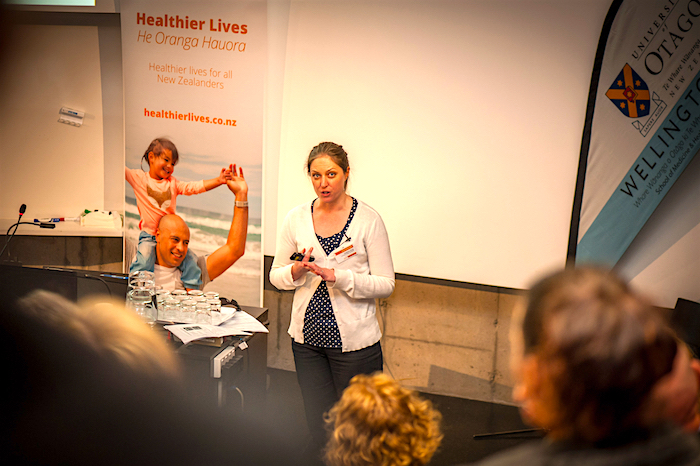Reaping the benefit of New Zealand’s health data
30 April 2017
‘Big Data’ is an increasingly important tool for health research worldwide, and can be an extremely cost-effective way of answering complex questions. In New Zealand we are fortunate to have some of the best national-level health and administrative data in the world but we are not yet making full use of this research opportunity.
Healthier Lives supports research opportunity
Healthier Lives is keen to support the infrastructure that will enable New Zealand researchers to tap into the gold mine of data available to them. We have funded the Virtual Health Information Network (VHIN) to undertake a two-year research project to answer four research questions associated with our mission to reduce the burden of cancer, cardiovascular disease, diabetes and obesity, and the inequities associated with these diseases.
The model for this project, which is also being tested, draws on a researcher who is an ‘academic champion’ for the question being investigated working together with researchers from VHIN who have expertise in big data. We think this model will strengthen collaboration and networks across universities and build the capacity of health researchers using big data.
New Zealand’s rich data sources
Since the 1990s, national health datasets such as mortality, cancer registrations and hospitalisations have been easily linkable through the National Health Index (NHI) number. More recently, outpatients, pharmaceuticals, laboratory, disability support services and other data have also been added to this ‘data-universe’.
The Ministry of Health has migrated some of this health data to the data platform used by Statistics New Zealand, which also houses social sector datasets about people and households in New Zealand, such as education, justice, income and benefits data.
Of course, all the data is anonymised and housed in a secure datalab so that it cannot identify individuals but can help answer important questions about the health of New Zealanders. Other countries can only look with envy at the very rich source of (as yet largely untapped) population health data available to New Zealand researchers through these linked data sets.
What is the Virtual Health Information Network?
The Virtual Health Information Network (VHIN) aims to help realise the full potential of this data by facilitating sharing and collaboration amongst researchers, analysts and other professionals in order to enhance health research outputs and improve health service delivery and health outcomes in New Zealand. This includes maintaining, fostering and contributing to forum discussions, the vhin.co.nz website, code-sharing, responding to queries and presenting on health research opportunities at conferences in meetings.
Healthier Lives has granted VHIN additional short term funding to sustain its core infrastructure. This will enable maintenance of a website and a closed technical group on Facebook to offer advice and support to other researchers about using big data, code sharing and accessing metadata from publicly accessible repositories. The VHIN team says that this funding will also help them to maintain publicly accessible stores of metadata and analytical code from previous health research and, importantly, to spread the word about the support available to researchers considering new projects using these datasets.
Applying the methodology: Canterbury earthquake study
The first question investigated for Healthier Lives was ‘what impact did the Canterbury earthquake have on the incidence of heart disease?’ This not only served as a successful trial run for the VHIN methodology but also looked into an issue of ongoing relevance to this country. Professor Vicky Cameron of the Christchurch Heart Institute, who leads Healthier Lives’ cardiovascular research project, was the academic champion who worked with Professor Tony Blakely and Dr Andrea Teng (photo above) from the VHIN.
At a recent seminar at the University of Otago Wellington (UOW), Dr Teng presented the preliminary results from this investigation, which found that there was an increased rate of hospital admissions from cardiovascular disease and myocardial infarction in the areas of the city that suffered the most damage. She noted various implications arising from these findings that need to be taken into account when formulating public policy relating to natural disasters, including the importance of:
- Limiting housing damage through building standards and land use planning
- Measures to reduce stress and promote wellbeing in the aftermath of an earthquake; and
- Ensuring adequate resources are available for primary care and hospitals in the management and prevention of cardiovascular disease in the areas with the most damage in the first year after the earthquake
Next questions to benefit
The next questions that VHIN will investigate on behalf of Healthier Lives relate to:
- The prevalence of cancer
- The productivity costs of heart disease
- Factors that can protect against the progression of pre-diabetes to diabetes particularly in Māori communities.
VHIN researchers Dr George Disney and Dr Naomi Brewer gave early updates about progress on each of these investigations at the UOW seminar.
More about the Virtual Health Information Network
For more information, see the VHIN website: vhin.co.nz, or e-mail the VHIN team at .
To join the VHIN facebook page, go to: https://www.facebook.com/groups/1658066281071881/.


